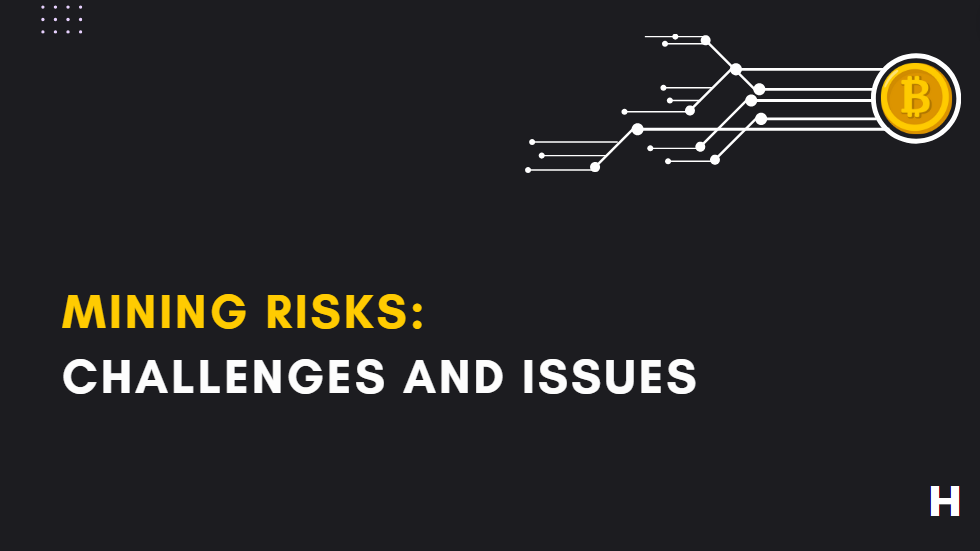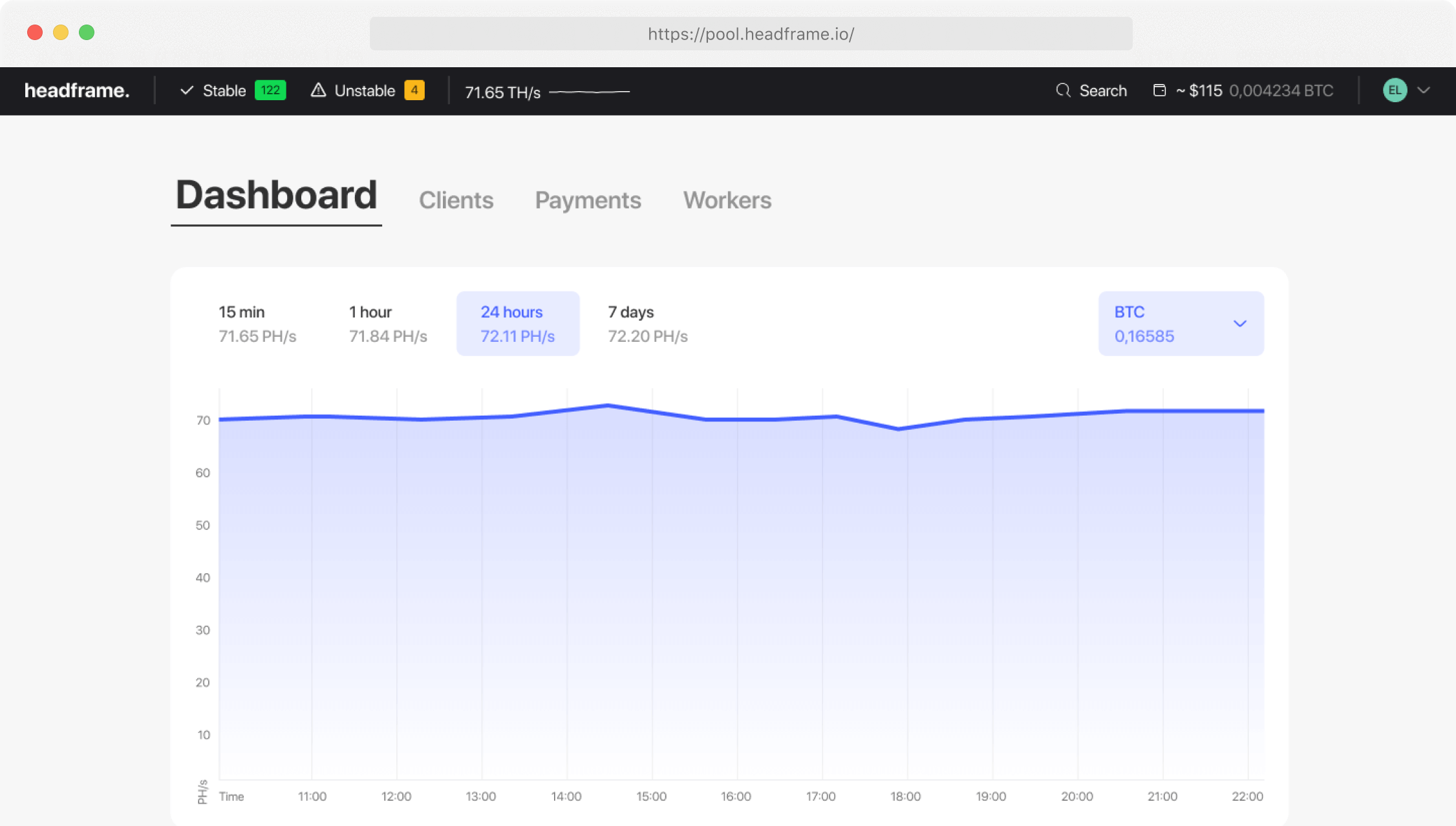
Risks of cryptocurrency mining: challenges and issues
- Risks of cryptocurrency mining in 2023
- Challenges of mining
- Risks and disadvantages of cryptocurrency mining
- Mining farm: risks and problems
- Fraud
- Problems with the state
- Conclusion
Risks of cryptocurrency mining in 2023
Earn more money with Headframe
Join a mining pool and get the best profitability in mining. Already more than 10,000 miners trust Headframe.
Cryptocurrency mining, the complex process by which new transactions are verified and added to the blockchain, has seen a growing interest in recent years. However, this growth comes with many risks and challenges that potential miners will have to face. The path into cryptocurrency mining starts with a substantial initial investment, primarily in specialized equipment, which can be a major hurdle for many.
What’s more, the ever-changing regulatory landscape adds further complexity. Governments around the world are trying to figure out how to regulate this relatively new industry, and potential regulatory changes could significantly impact the profitability and legality of coin mining.
Another major concern is the environmental footprint of cryptocurrency mining. The process is known for its high energy consumption, which has led to increased scrutiny and criticism, especially in an era that is increasingly focused on sustainability.
The digital nature of cryptocurrency also exposes miners to cybersecurity risks. Coin mining operations, because of their potential for profit, are attractive targets for cybercriminals. This threat emphasizes the importance of strong security measures in coin mining operations.
Finally, the inherent volatility of the cryptocurrency market introduces an element of unpredictability to the profitability of coin mining operations. The value of cryptocurrencies can fluctuate, and these price fluctuations directly affect mining profits.
In this article, we address these and other risks, providing a comprehensive overview of the challenges facing cryptocurrency mining in 2023.
Risks of cryptocurrency mining in 2023
Challenges of mining
Cryptocurrency mining, while it can be lucrative, comes with several significant challenges. Here are some of the major problems associated with it:
- High energy consumption: Cryptocurrency mining, especially Bitcoin mining, requires a significant amount of energy. This not only results in high operational costs, but also raises environmental concerns due to the carbon footprint associated with energy production.
- Equipment Costs: Cryptocurrency mining requires specialized equipment known as ASICs (Application-Specific Integrated Circuit), which can be quite expensive. The cost of installing and maintaining these machines can be high, and they can quickly become obsolete as technology advances.
- Regulatory uncertainty: The legal status of cryptocurrency mining varies from country to country. Some countries have embraced cryptocurrencies and blockchain technology, while others have banned or restricted their use. This regulatory uncertainty can pose a significant risk to miners.
- Market volatility: The value of cryptocurrencies can fluctuate significantly, which can significantly affect the profitability of mining. If the price of the cryptocurrency being mined drops, miners may not be able to recoup their initial investment in equipment and electricity.
- Technical Knowledge: Understanding the process of mining and maintaining a mining rig requires a certain level of technical knowledge. This can be difficult for people without a background in computer science or related fields.
- Network scalability: As the number of transactions in a blockchain increases, its size increases. This can lead to network scalability issues, potentially slowing down transaction processing times and increasing costs.
Risks and downsides of cryptocurrency mining
Cryptocurrency mining, despite the potentially significant rewards, also comes with a number of risks and downsides:
- Financial Risk: Cryptocurrency mining requires a significant upfront investment in specialized equipment. In addition, operating costs, especially electricity costs, can be substantial. The profitability of mining is closely linked to the market price of the mined cryptocurrency, which can be highly volatile. If the price drops significantly, miners may not be able to recoup their investment.
- Equipment obsolescence: Cryptocurrency mining technology is evolving at a rapid pace. New, more efficient equipment can quickly render old equipment irrelevant. This means that miners may need to regularly invest in new equipment to stay competitive.
- Energy consumption and environmental impact: Cryptocurrency mining, especially pruf-o-wark mining, requires high energy consumption. High energy consumption contributes to climate change and can attract criticism and regulatory attention. In regions where electricity is generated primarily from fossil fuels, the environmental impact is even greater.
- Regulatory risk: The regulatory environment for cryptocurrency is uncertain and can change rapidly. Some countries prohibit or strictly regulate cryptocurrency mining due to concerns about fraud, money laundering and energy consumption. Changes in regulation can have a significant impact on the profitability and legality of mining operations.
- Centralization: Although cryptocurrencies are theoretically decentralized, in practice, mining power is often concentrated in a few large pools of miners. This centralization can lead to a number of problems, including increased vulnerability to 51% attacks, in which a single individual gains control of the majority of the network’s processing power and can manipulate the blockchain.
- Security Threats: Cryptocurrency miners are often targeted by cybercriminals. Threats can include malware that hijacks mining equipment, attacks that steal cryptocurrency, and ransomware attacks.
- Noise and heat: Mining equipment, especially in large quantities, can generate a significant amount of heat and noise. This can make a mining location uncomfortable and require additional investment in cooling and soundproofing.
- Electronic debris: Mining equipment, especially specialized ASIC miners, can contribute to electronic debris. These devices are often designed for a specific algorithm and cannot be reused when they become inefficient for mining.
These risks and downsides emphasize the need for careful research and for all potential miners to take into account the ability to manage these challenges.
Mining farm: risks and challenges
Cryptocurrency mining farms, where multiple mining rigs are set up to mine cryptocurrency, are becoming increasingly common as the crypto industry grows. While these operations can be highly profitable, they also come with unique challenges and risks.
Challenges of mining farms:
- Energy Consumption: One of the most significant challenges faced by mining farms is their significant energy consumption. A large number of mining rigs operating simultaneously results in high energy consumption, which can lead to significant operational costs and logistical difficulties in securing accessible locations where such energy requirements can be met.
- Cooling: Mining equipment generates a significant amount of heat. In large-scale mining operations such as mining farms, efficient cooling systems are necessary to prevent equipment damage. Implementing these systems increases the complexity and cost of the operation.
- Space requirements: Accommodating multiple mining rings requires a large amount of physical space. This limitation can restrict the choice of location for a mining farm and increase operating costs.
- Maintenance needs: With multiple machines running, regular maintenance becomes a significant challenge. Ensuring that all machines are working properly is essential to keep a mining farm up and running, as any downtime can result in significant financial losses.
Risks of mining farms:
- Financial Risks: Setting up a mining farm requires a significant initial investment. Due to the volatility of cryptocurrency prices, there is a risk that the operation may not pay off and may result in significant financial losses.
- Regulatory Risks: Mining farms, like individual miners, are subject to regulatory risks. Some regions have strict restrictions or outright bans on cryptocurrency mining. Any changes to these regulations could significantly affect the legality and profitability of operations.
- Security Risks: Due to the high cost of the equipment and cryptocurrencies mined, mining farms can be an attractive target for physical and cyber thieves. Implementing robust security measures is essential to protect the operation.
- Environmental implications: The environmental impact of mining farms is significant due to their high energy consumption. This can lead to regulatory scrutiny and potential reputational damage, especially in today’s increasingly environmentally-oriented society.
- Equipment obsolescence: Due to the rapid advancement of technology, mining equipment can quickly become obsolete. Replacing outdated equipment can be a significant expense for a mining farm.
- Market Volatility: The profitability of a mining farm is closely tied to the price of the cryptocurrencies being mined. Market volatility can significantly affect the financial viability of an operation.
Scams
Cryptocurrency mining, although promising significant profits, is not without its pitfalls. One of the biggest challenges in this industry is the proliferation of fraud. As the industry evolves and expands in 2023, it is important to understand the various forms of fraudulent activity that can occur in cryptocurrency mining.
- Phantom mining operations
In some cases, fraudsters may create phantom mining operations. They lure investors with promises of high profits from mining operations. However, these operations either do not exist or do not generate the claimed profits. They are essentially Ponzi schemes in which payments to the first investors are made through contributions from new investors.
- Cloud mining scams
Cloud mining allows people to participate in cryptocurrency mining without having to invest in and maintain expensive equipment. However, this area is saturated with scams, with many fake companies offering cloud mining services, accepting users’ money but not providing the promised revenue.
- Cryptojacking
This form of fraud involves using malware to hijack the processing power of unsuspecting users’ computers to mine cryptocurrency. Unauthorized use of resources can result in system slowdowns and increased energy costs for victims.
- Initial coin offering (ICO) scams
Some mining projects may attempt to raise capital through initial coin offerings (ICOs). While many ICOs are legitimate, others are fraudulent, designed to take money from investors with no intention of developing a successful mining operation.
- Market Manipulation
Some large-scale miners or mining pools may attempt to manipulate the cryptocurrency market to increase their profits. This can include practices such as self-mining, where miners process their own wallet transactions to earn commissions.
- Unrealistic profit promises
Some mining operations may attempt to attract investors with promises of high and guaranteed profits. Given the volatile and unpredictable nature of the cryptocurrency market, such guarantees are unrealistic and often a sign of fraudulent intentions.
In conclusion, as the cryptocurrency industry continues to evolve in 2023, potential investors and mining participants must remain vigilant against these and other forms of fraud. Thorough research and valid due diligence are essential before investing in any mining operation. Remember, if an offer seems too good to be true, it probably is.
Problems with the government
Government regulation of cryptocurrency mining could present significant challenges for miners and mining operations. Here are a few key issues related to government regulation in 2023:
- Regulatory unpredictability: The regulatory environment for cryptocurrencies is still evolving. Many countries, including the U.S., are working to establish an effective set of rules for digital assets. This uncertainty can make it difficult for miners to plan operations and investments.
- Compliance Requirements: Depending on the jurisdiction, miners and mining operations may be required to comply with a number of regulations. These may include financial regulations, anti-money laundering rules and reporting requirements. Compliance can be complex and costly, especially for large-scale mining operations.
- Taxation: The issue of taxation of cryptocurrencies is complex and varies from jurisdiction to jurisdiction. Miners need to understand how their mining profits will be taxed, which can be complicated due to the volatility of cryptocurrency prices.
- Environmental regulation: Given the high energy consumption of cryptocurrency mining, miners may face regulatory scrutiny regarding environmental impacts. Some jurisdictions already have or are considering limiting the energy consumption of mining operations.
- Regulatory Change Risk: The legal environment for cryptocurrencies can change rapidly. New laws or regulations, as well as changes to existing ones, can have a significant impact on the profitability and legality of mining operations.
- International differences: There are significant differences in the regulation of cryptocurrencies between countries. This can create problems for miners operating in multiple jurisdictions or utilizing cloud mining services based in different countries.
Thus, government regulation is a significant challenge for cryptocurrency mining. Miners need to be aware of the regulatory environment in their jurisdiction and prepared to adapt their operations as necessary. It is advisable to seek legal advice to ensure compliance with all relevant rules and regulations.
Conclusion
In conclusion, cryptocurrency mining, especially on a large scale such as mining farms, presents a complex landscape of risks, challenges, and regulatory issues. From high operating costs, significant energy consumption and the need for regular maintenance to the potential for fraud and market manipulation, the world of cryptocurrency mining is filled with potential dangers.
In addition, the regulatory environment adds another layer of complexity. With ever-changing regulations, compliance requirements, taxation issues and environmental considerations, miners need to navigate a rapidly changing landscape. International differences in legislation further complicate this situation, especially for those operating in multiple jurisdictions.
Despite these complexities, cryptocurrency mining still attracts interest because of the potential for significant profits. However, it is crucial for potential miners and investors to conduct thorough research and due diligence before embarking on such ventures. Understanding the risks, being aware of the regulatory environment and being prepared to adapt to change are key to successfully navigating the complex world of cryptocurrency mining in 2023.


